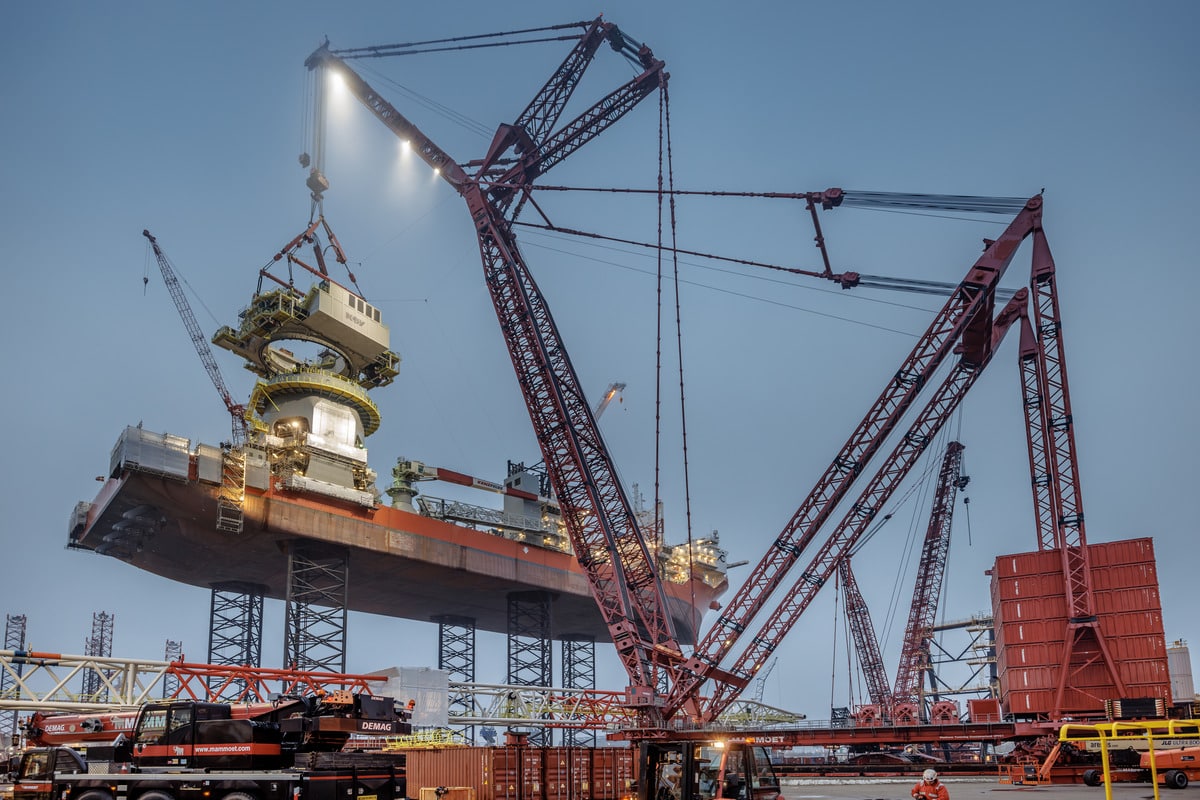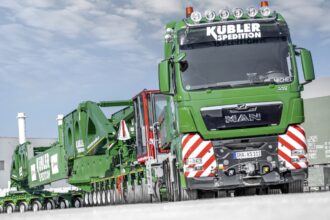Colossal Crane with a Small Footprint
CONTRACTED BY GUSTOMSC, MAMMOET HAVE CARRIED OUT LEG CRANE REPLACEMENTS ON TWO OFFSHORE WIND FARM INSTALLATION JACK UP VESSELS (WIND ORCA AND WIND OSPREY) FOR THE DANISH TRANSPORT AND INSTALLATION COMPANY CADELER.
When it comes to wind turbines, the bigger they are, the harder they work, generating more renewable offshore wind energy, and a greater return on investment for developers. As a result, next-gen turbines are growing, and their components are getting larger and heavier.
This project represented a unique one for Mammoet, utilizing not only one of the biggest cranes in its fleet but also its own yard in Schiedam to perform the job – the location allowing a rare opportunity to schedule projects simultaneously to greatly increase their efficiency.
For the project, Mammoet utilized its PTC210-DS crane, one of five 5000t class ring cranes in its fleet and one of the largest cranes in the world. The colossal size and stature of the crane belie its greatest strengths – its versatility and ability to operate in areas where space is limited.
Dirk Knoester, Senior Adviser at Mammoet, explains: “The PTC210-DS is the perfect crane for this job. It has a relatively small footprint combined with 360-degree slewing, with the possibility to switch between fixed and luffing jib mode (as only the PTCs can) resulting in the largest possible working area.”
“PTC cranes can also be assembled in numerous configurations and thus a tailor-made configuration is feasible for any job: different mainboom and jib lengths, fixed or luffing jib, different amounts of counterweight and two ring diameters.”
These attributes made it an ideal crane for this project, where jack-up vessels were to be positioned on either side of Mammoet’s quay – which has a peninsula configuration. So, flexibility was needed to allow two vessels to be worked on together.
The decision to have the PTC210-DS constructed in Mammoet’s own yard was driven by safety and optimizing the schedule for the client by being able to refit both vessels at once.
Remco Zandstra, Senior Commercial Manager at Mammoet, said: “Our yard has a unique location in the port of Rotterdam, and this gave us the possibility to position the crane between the two vessels and serve them at the same time. Not only does this save considerable time, by minimizing movements of cranes in the yard and vessels along the quay, it also creates the safest possible solution to perform this project.”
With Wind Orca and Wind Osprey moored on opposite sides of the quay, the PTC210-DS could be positioned in the center, slotted between both vessels.
Safety assessments were carried out at the start of the project. This was essential as surveys found that the dock itself consisted of two L-shaped concrete constructions with softer ground in the middle.
A soil survey was conducted at the proposed location of ring crane and, using this data, calculation models were created to predict the settlement of the soil under its weight.
To verify these models, load tests were carried out at both locations where the ring crossed areas without a dock floor.
The new leg cranes comprised four main sections to be installed: the pedestal, the rotating platform, the A-Frame and the 149m mainboom.
To enhance stability and control during the mainboom lifts, an LR1800-1.0 crawler crane was used as an assist crane. Working together, the PTC210-DS lifted one end of the boom as the crawler crane lifted the other.
Performing this operation on a busy quay was a challenge that required effective space management. Mammoet’s Schiedam location serves many active projects in Belgium and the Netherlands on a daily basis. The site had to serve as a temporary laydown area for all components being added to the Wind Orca and Wind Osprey, including the large booms.
Lifting height proved another test for the engineers. At different stages of the operation, the vessels had to be raised to a height of 73 meters above the quay using their jacking legs.
Jacking up the vessels to this height was necessary to keep the rigging short, since the new cranes are of the leg encircling type. This meant that the base of these cranes had to be lifted over the leg.
Thus, jacking up the vessels minimized the risk of collisions between the jack-up leg and sections of the PTC210-DS crane during lifts.
As crew could not embark and disembark the ships once they were elevated, additional safety considerations were taken to ensure that only authorized personnel – to operate the jacks and raise the vessels – were allowed aboard.
Work on Wind Orca and Wind Osprey will continue this year, with completion anticipated later in 2024.
This project marks a special partnership between two neighboring companies that has been symbolized by the Rotterdam skyline greeting one of the largest cranes in the world.









